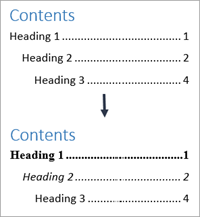

- #Word 2016 table of contents extra lines how to
- #Word 2016 table of contents extra lines full
Which is appropriate depends on what version of Word you have.Ĭase 3: Text wraps around the picture. There are three ways to wrap text around a figure and its caption. Modify your custom style so that (a) Line spacing is set to Single and (b) Paragraph format is set to Keep With Next. Word does not have an appropriate one built-in, so create a custom style. If you have more than one figure in your document, each with its own caption, the most efficient way is to use a style especially for your figures.

However, that will only work for this figure. That will ensure that the paragraph containing the figure is always on the same page as the following paragraph (which holds your caption). On the Line and Page Breaks tab, tick "Keep with next". In Word 2007 or Word 2010: On the Home tab, in the Paragraphs group, click the dialog launcher at the bottom right corner of the Paragraphs group to display the Paragraph dialog box.In Word 2003 and earlier: Format > Paragraph.Now, tell Word to keep this paragraph on the same page as the next paragraph.
Note: Make sure that you don't leave an empty paragraph between the title and the figure.Ĭase 2: Caption is below the picture and is the full width of the page. That will ensure that all captions you insert will stay on the same page as the following paragraph. In the Modify Style dialog box, do Format > Paragraph. For information on how to do that, see How to modify styles in Microsoft Word We can do that by modifying the Caption style to "Keep with next".
Now, make sure the title will stay on the same page as the figure. Word will automatically insert the title in Caption style. In Word 2007 and Word 2010: References > Insert Caption. In Word 2002 and Word 2003: Insert > Reference > Caption. In Word 2000 and earlier: Insert > Caption. Click in the empty paragraph, ready to type some text. To do that, ensure there is an empty paragraph above the figure. Make sure the figure is in-line (not floating). Title is above the figure.Ĭase 1: Title is above the picture, and is the full width of the page. Figure is a full page width (or nearly a full page width). A table is the full width of the page (or nearly a full page width). Title is above the figure, or, caption is below the figure.Ĭase 4. Figure is a full page width (or nearly a full page width. This page describes several ways to keep a figure, photograph, clipart, graphic, table or other element on the same page as its title or caption.Ĭlick on the best match from the following list ("figure" here means anything except a table):Ĭase 1. Use a Frame to group paragraphs that need to "float". Use Keep With Next to keep one paragraph on the same page as the next paragraph.






 0 kommentar(er)
0 kommentar(er)
